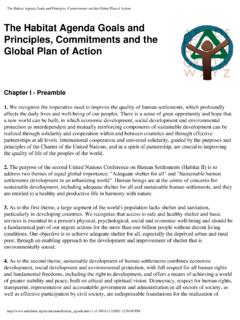Transcription of Slums: Some Definitions - UN-Habitat
1 Slums: Some DefinitionsUN-HABITAT defines a slum household as a group of individuals living under the same roof in an urban area who lack one or more of the following:1. Durable housing of a permanent nature that protects against extreme climate Sufficient living space which means not more than three people sharing the same Easy access to safe water in sufficient amounts at an affordable Access to adequate sanitation in the form of a private or public toilet shared by a reasonable number of Security of tenure that prevents forced all slums are homogeneous and not all slum dwellers suffer from the same degree of deprivation. The degree of deprivation depends on how many of the five conditions that define slums are prevalent within a slum household. UN-Habitat analyses show that Sub-Saharan Africa s slums are the most deprived; over 80 per cent of the region s slum households have one or two shelter deprivations, but almost half suffer from at least two shelter deprivations.
2 Approximately one-fifth of slum households live in extremely poor conditions, lacking more than three basic shelter needs. Generally, the lack of sanitation and water in the region s slums is compounded by insufficient living space for families and inadequate, makeshift housing. In the diagrams below, even though any one of the above five conditions are used to identify slums, only the first four contribute to a definition of those who suffer from shelter deprivation. Though lack of security of tenure is one of the conditions in most slums, it is not directly related to an assessment of shelter & FIGURE PROPORTION OF SLUM HOUSEHOLDS IN DEVELOPING REGIONS BY NUMBER OF SHELTER DEPRIVATIONS, 2001 Source: UN-Habitat 2005, Urban Indicators Programme, Phase is a UN-Habitat Feature/Backgrounder, please feel free to publish or quote from this article provided UN-Habitat is given credit. Suitable photographs are available on our website.
3 For further information, please contact: Mr. Sharad Shankardass, Spokesperson, or Ms. Zahra Hassan, Press & Media Liaison, Press & Media Relations Unit, Tel: (254 2) 7623153/7623151, Fax: (254 2) 7624060, E-mail: Website: : Neither Bricks nor Mortar, Non-Durable Housing Worldwide, 18% of all urban housing units (some 125 million units) are non-permanent structures and at least 25% of all housing (175 million houses) does not meet urban construction codes. This figure, in reality, is probably much higher. For every 10 non-permanent houses in the cities of developing countries, 3 or 4 are located in areas prone to floods, landslides, hurricanes and earthquakes. More than 10% of the urban population in Sub-Saharan Africa lives in non-durable housing. But in North Africa, 99% of the total urban population lived in durable houses in 2003. Government investment has improved slum housing in cities in Egypt, Benin, Rwanda and Tanzania.
4 More than half the people in the developing world who live in unsafe houses are Asian, many of them Indian, Nepalese and Pakistani. In many regions of Asia little significant progress and in providing adequate shelter has been made with exceptions such as the Indonesian cities of Bitung and Jaya Pura. In 2003, more than 99% of the population of Latin America and the Caribbean lived in adequate housing although slum dwellings in Guatemala, Nicaragua and Peru do not meet the UN-Habitat standard. In Nicaragua, when floor and roof materials are assessed to determine housing quality, only 9% of the urban population lives in a durable HOUSING DURABILITY AMONG URBAN POPULATIONS IN DEVELOPING REGIONS, 2003 FIGURE DISTRIBUTION OF THE URBAN POPULATION LACKING FINISHED FLOOR MATERIALS IN DEVELOPING REGIONS, 2003 Source: UN-Habitat (2005), Urban Indicators Programme Phase III and United Nations, World Urbanization Prospects; The 2003 : Access to finished main floor materials was computed from Demographic and Health Surveys (DHS) data.


